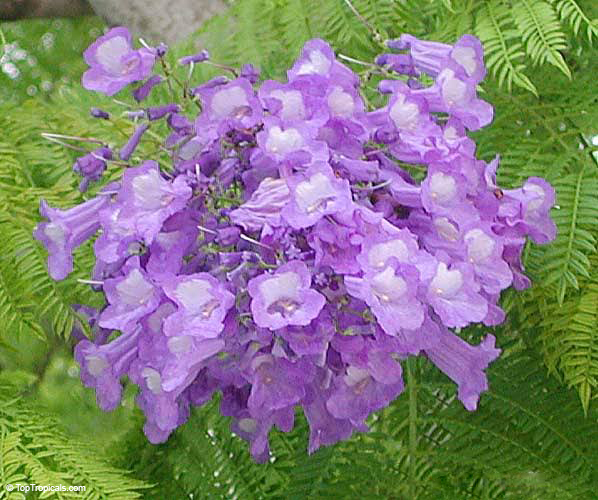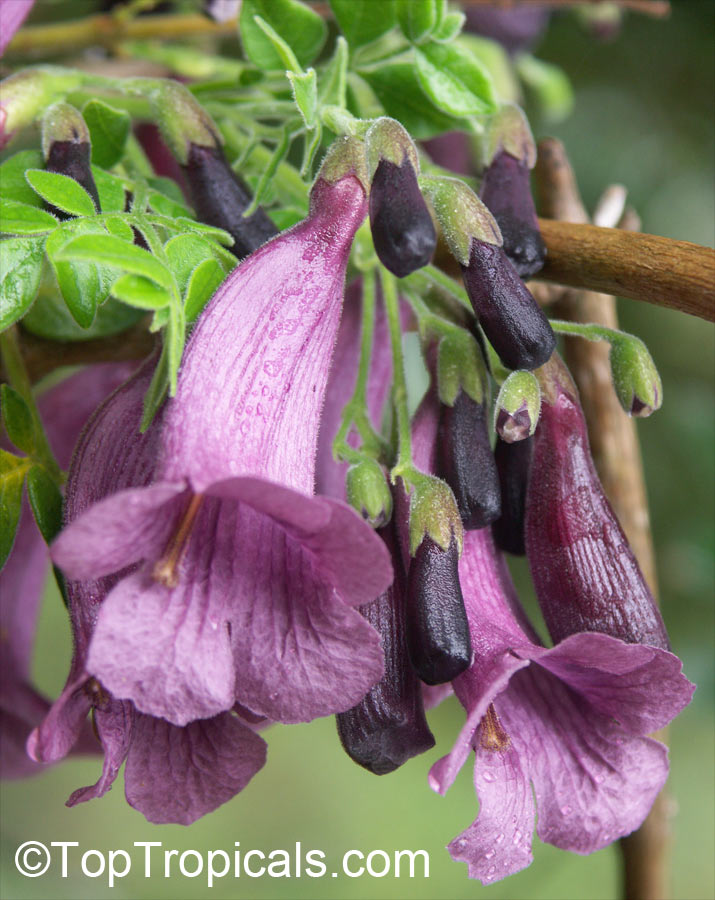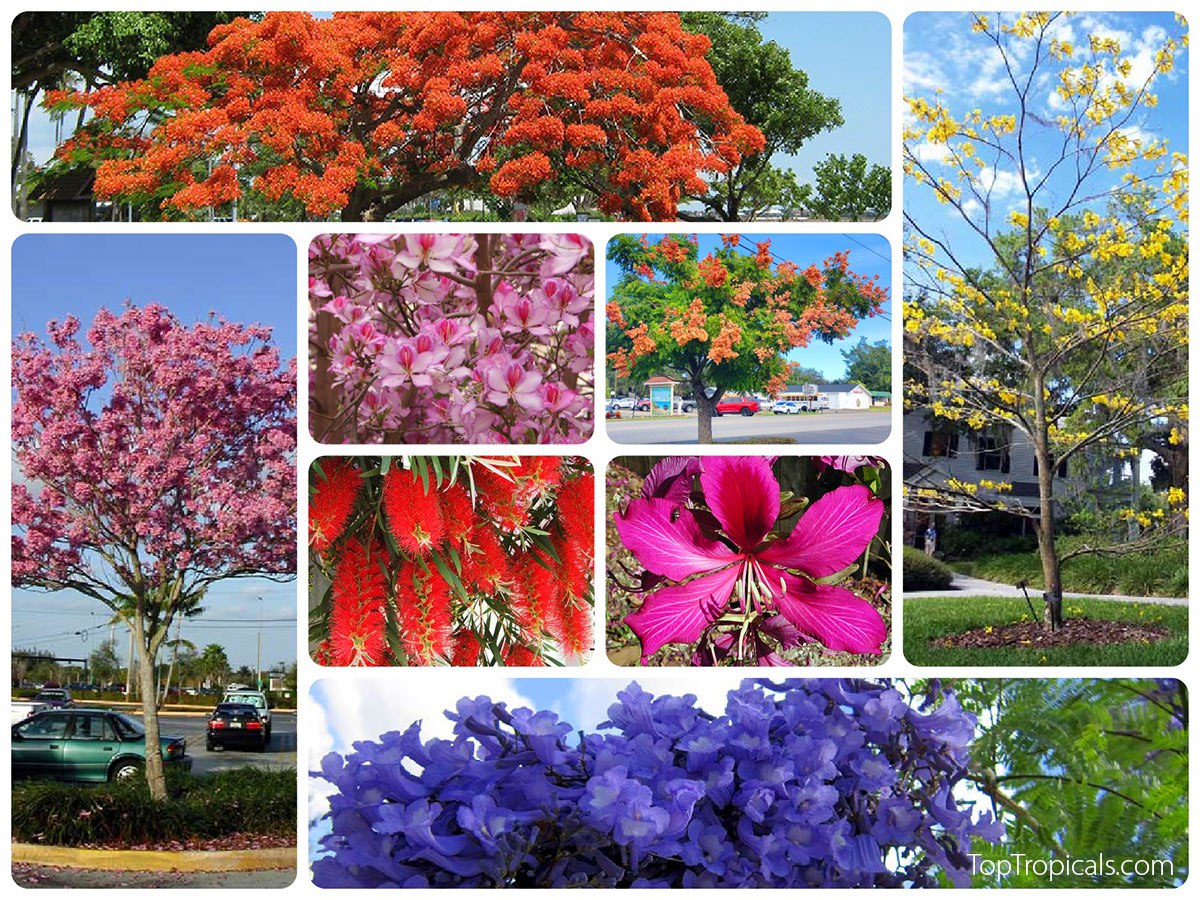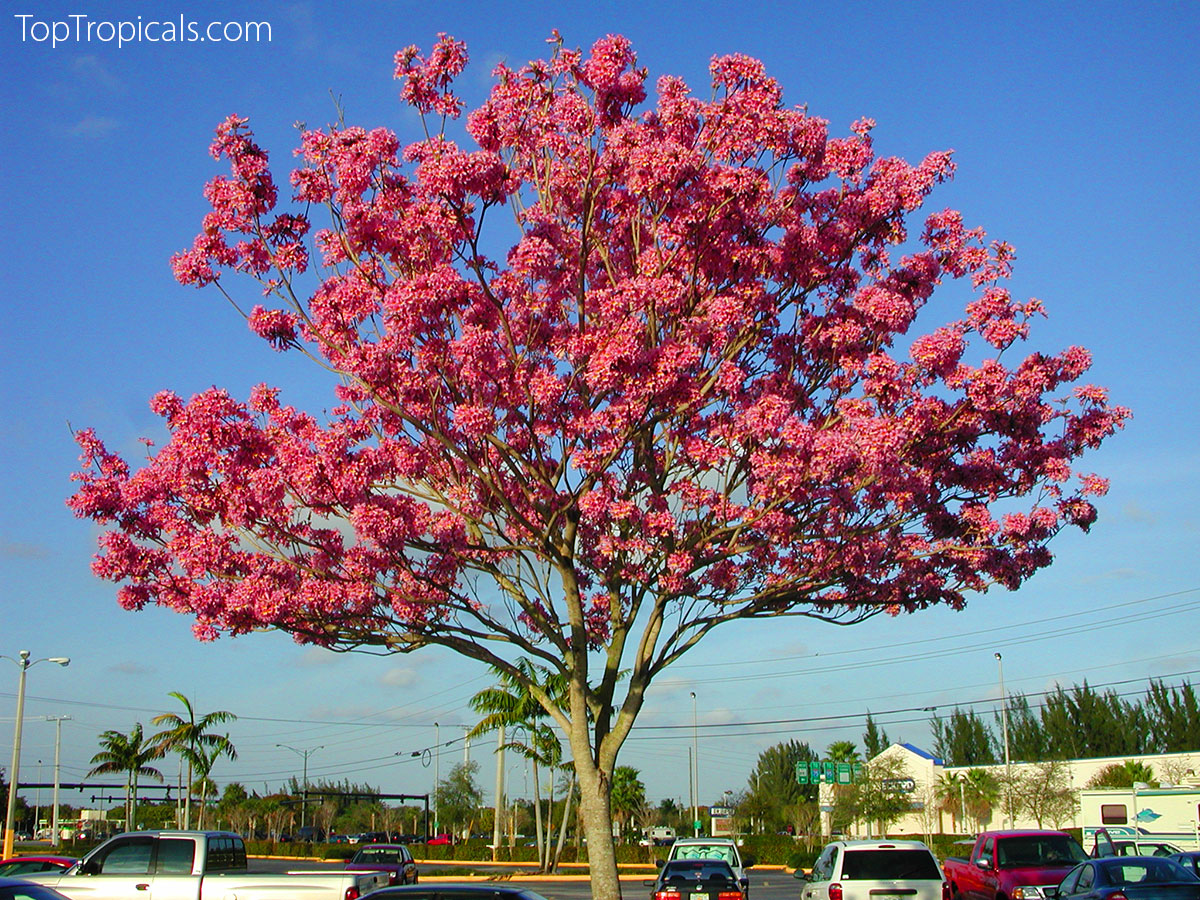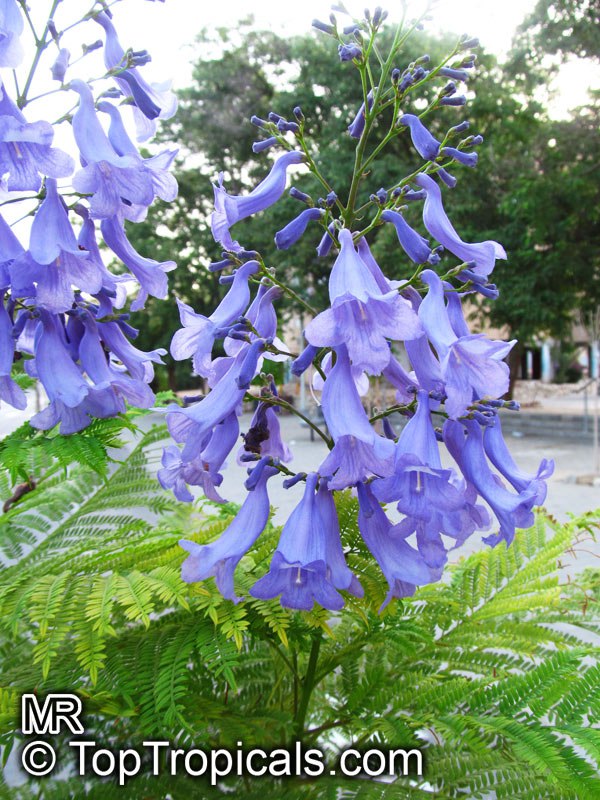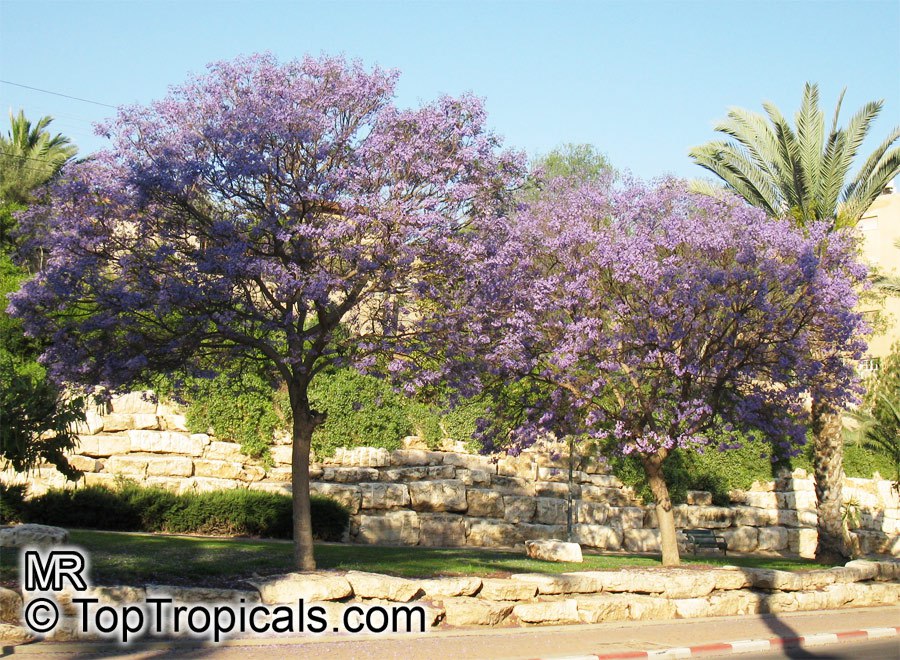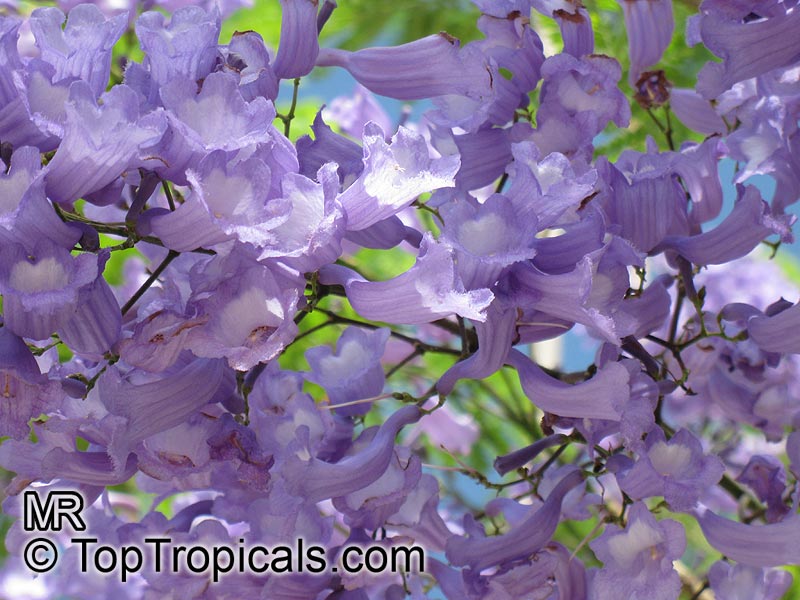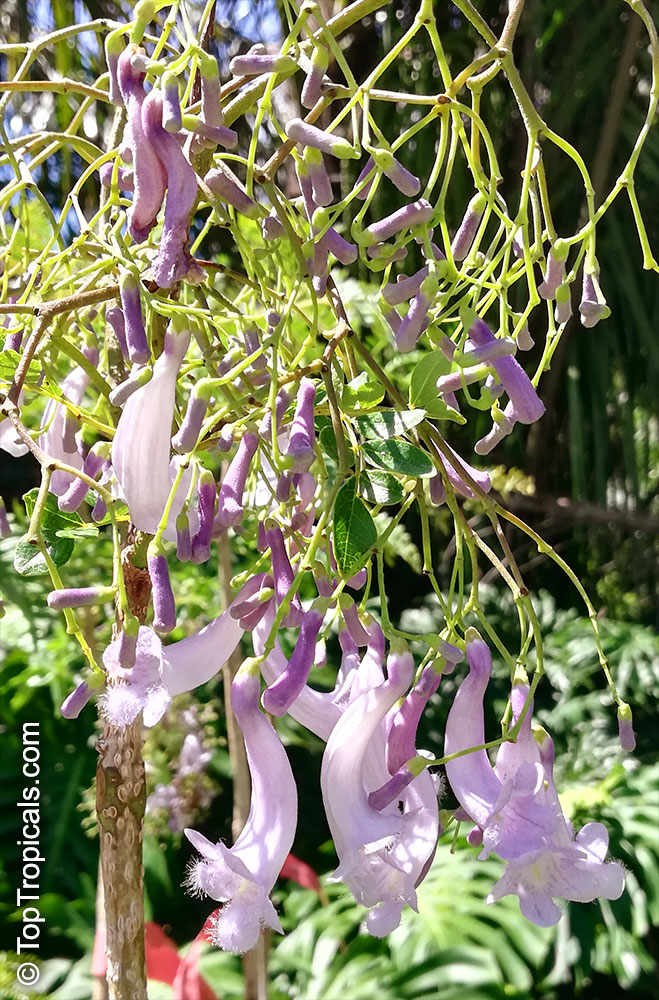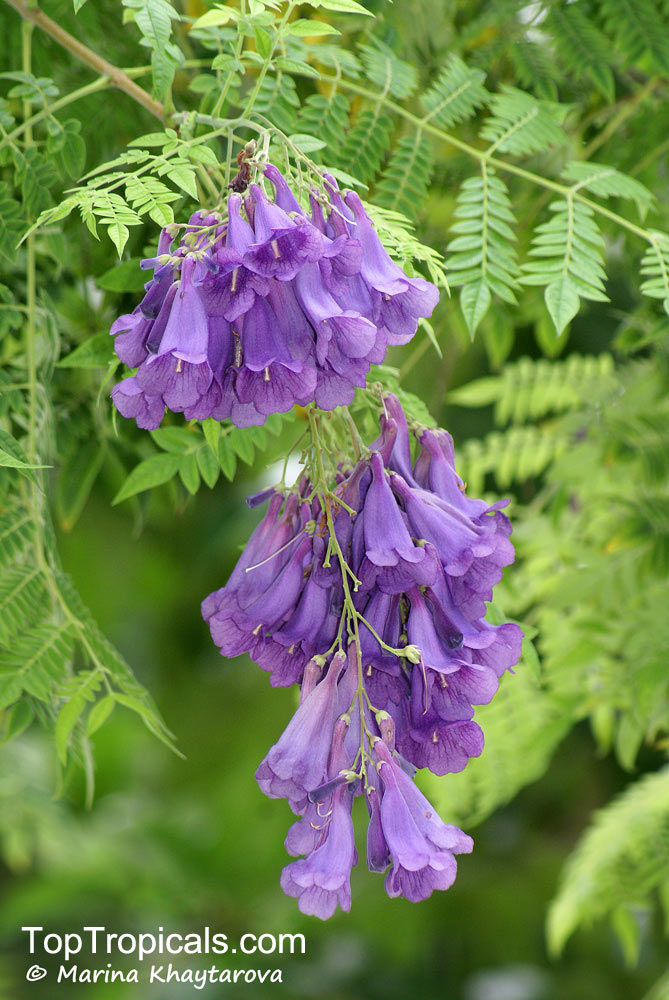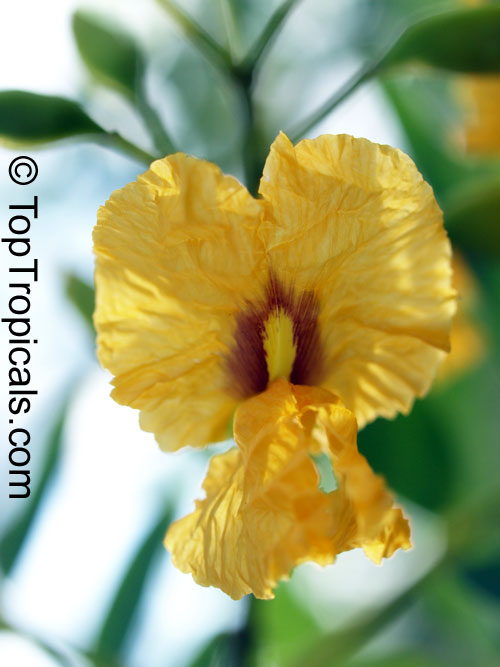Big color in a small tree: Maroon jacaranda and why Jacaranda trees are so popular
Maroon jacaranda - Jacaranda jasminoides
- 💜 Jacaranda jasminoides (Maroon Jacaranda) is a charming, compact tree that brings a touch of drama to small gardens and patios. It grows 10-12 feet tall, with a bushy habit that makes it perfect for tight spaces or even containers.
- 💜 What really steals the show are its deep maroon to dark purple trumpet-shaped flowers that bloom in clusters from late spring through summer. In warm climates, it may surprise you with blooms at other times too!
- 💜 The fine, fern-like leaves add a delicate, lacy texture to the overall look.
- 💜 This jacaranda loves full sun but will tolerate a bit of shade, and it is happiest in fertile, well-drained soil. Water it regularly when it is young or during dry spells, but once established, it is fairly easygoing. It s best suited for USDA zones 9 to 11, and while mature plants can handle brief cold snaps down to 20F, younger ones appreciate a little extra protection when the temps dip.
- 💜 Whether in the ground or in a pot, the Maroon Jacaranda is a low-maintenance beauty. A little pruning here and there keeps it tidy, and its elegant blooms make it a standout wherever it s planted. In warm places it may keep its foliage year-round, giving you a long-lasting touch of tropical color. A great pick for anyone who wants big color in a small footprint!
📚 Learn more:
- · Hypnotizing Purple Tango of Jacaranda
- · Three top tropical trees - from the legends of Caribbean
- · Awe-inspiring Jacaranda and its legends
🛒 Shop Jacaranda trees
#Trees #Container_Garden
🟢 Join 👉 TopTropicals
Date:
⭐ The Winter Stars: 8 Flowering Trees That Steal the Show
8 Best Flowering Trees That Bloom in Winter: Royal Poinciana with red-orange canopy, Dwarf Pink Tabebuia, Dwarf Golden Tabebuia, Pink Butterfly Orchid Tree, Golden Rain Tree, Weeping Red Bottlebrush, Hong Kong Orchid Tree, and Jacaranda with purple flowers.
Royal Poinciana (Delonix regia)
The diva of tropical trees. Huge red-orange flowers blanket the branches
from late winter through summer. If you’ve ever seen one in full
bloom, you know — it stops traffic.
Best in large yards or open spaces, but young ones do great in big pots for
a few years.
🛒 Shop
Tatiana: “If you want a tree that makes
people
say ‘wow,’ this is it.”
Tabebuia chrysotricha – Dwarf Golden Tabebuia
Small tree, big drama. It turns solid gold just before new leaves appear. Blooms while completely bare — a stunning contrast of yellow on brown wood. Perfect for patios, courtyards, and containers. Handles cool nights down to the mid-20s F. Bright, cheerful, and forgiving — the kind of tree that always looks like it’s celebrating. 🛒 Shop
Tabebuia impetiginosa – Dwarf Pink Tabebuia (Pau D’Arco)
The Florida “cherry blossom.” Pink-lavender flowers smother the branches each winter, often before any leaves return. Thrives in sandy soil, tolerates drought, and grows beautifully in large planters or pots indoors near a sunny window. Ideal for seasonal residents or anyone who wants color when everything else is asleep. 🛒 Shop
Jacaranda mimosifolia
If color had music, this would be jazz. Soft, fern-like leaves and cascades of violet-blue trumpet flowers — airy, elegant, unforgettable. Outdoors, it makes a graceful shade tree; in containers, it stays compact with regular pruning. Jacarandas reward patience — they bloom bigger each year. 🛒 Shop
Koelreuteria paniculata – Golden Rain Tree
A favorite for its surprises — golden blooms in summer, pink paper lantern pods in fall, and bronze leaves before rest. Fast-growing, tough, and easy. Loves full sun and moderate water. Great for open lawns or patio tubs. The kind of tree that gives you something new to look at every month. 🛒 Shop
Callistemon citrinus – Bottlebrush Tree
The hummingbird magnet.
Bright red, brush-shaped flowers bloom several times a year —
sometimes even in cool weather.
The dwarf form, ‘Little John,’ stays about 4 feet tall, perfect
for pots or small borders.
Trim lightly after flowering to keep it compact and colorful. 🛒
Shop
Tatiana: “If you’ve never grown a
tropical tree before — start here. It’s the friendliest
one.”
Bauhinia variegata – Pink Butterfly Tree
Graceful, fragrant, and forgiving. Its pink-lavender orchid-like flowers open from late winter through spring, filling the garden with color and pollinators. It’s fast-growing, drought-tolerant, and excellent for both ground and pots. Even the buds are edible — a fun bonus for adventurous gardeners. 🛒 Shop
Bauhinia blakeana – Hong Kong Orchid Tree
The queen of them all.
Huge magenta-purple blooms that last for months, from fall through spring.
Fragrant, clean (no messy seed pods), and perfect for patios or large
decorative containers.
Give it sun, a little water, and it will reward you with bloom after bloom.
🛒 Shop
Tatiana: “It’s the one tree that never lets winter
win.”
A note on grafted Hong Kong Orchid Trees: Most Hong Kong Orchid Trees are grafted, and that’s actually a big advantage. Because they don’t grow from seed, grafted plants mature faster and begin blooming while still small — sometimes within the first year. That makes them perfect for patio pots or small gardens where space is limited.
Bringing the Tropics Home
Whether your garden faces the Gulf or your window faces the snow, these trees let you live in color year-round. Plant them outdoors in warm zones or grow them in pots indoors — they adapt, they bloom, they brighten every corner.
Gardening isn’t about waiting for spring — it’s about finding joy in every season. And when a tree blooms in January, that joy feels twice as sweet.
🛒 Shop Winter Flowering Plants
✍️ Winter Bloomer Q&A
Q: Can these trees really bloom indoors?
Yes! Smaller species like Bottlebrush ‘Little John,’ Dwarf Tabebuias, and many Bauhinias bloom beautifully in pots with bright light or grow lamps.
Q: Do they lose their leaves in winter?
Some, like Tabebuias and Jacarandas, drop leaves right before blooming — it’s normal and part of their charm. Others, like Bottlebrush, stay evergreen.
Q: What fertilizer works best?
We use Sunshine Boosters — gentle, balanced, and perfect for tropicals. Feed every 2–3 weeks during active growth.
Q: How do I know when to water?
Touch the soil! If it’s dry an inch or two down, water deeply. Overwatering is the main mistake with tropicals.
Q: Can they handle frost?
A quick dip into the upper 20s F is fine for most mature trees. Cover young ones or move containers under shelter if colder.
Q: Which are best for beginners?
Start with Bottlebrush ‘Little John’ or Golden Tabebuia — compact, colorful, and nearly foolproof.
Q: When will they bloom?
Usually within few years if they get enough sun and warmth. Grafted plants blooms much sooner
Q: Which of these trees are best for pot growing?
For patios, balconies, or indoor sunrooms, choose the compact or grafted types:
- Tabebuia chrysotricha, Dwarf Golden Tabebuia, bright and easy.
- Tabebuia impetiginosa, Dwarf Pink Tabebuia, hardy and long-blooming.
- Callistemon ‘Little John’ – stays neat and flowers all year.
- Grafted Bauhinia blakeana – blooms while young, perfect for pots.
🎥 Watch videos of Dwarf trees in bloom:
Why the Purple Tango of Jacaranda is so hypnotizing
- 💜 The Jacaranda Tree enchants with its stunning purple-blue trumpet-shaped blooms that create a mesmerizing, lilac carpet when they fall.
- 💜 A true spectacle of spring, its fern-like leaves and fast-growing nature make it perfect for landscaping. It’s often compared to dancing in the streets of Buenos Aires or Pretoria, where Jacarandas paint the cities in a dazzling purple.
- 💜 This tree is not just eye candy but a symbol of wisdom, rebirth, and good fortune, rooted in legend and tradition.
📚 Learn more:
- · Three top tropical trees - from the legends of Caribbean
- · Awe-inspiring Jacaranda and its legends
🛒 Plant your own Purple Jacaranda tree
#Trees
🔴 Join 👉 TopTropicals
Date:
Season star:
The Purple Tango of Hypnotizing Jacaranda
by Alex Butova, the Witch of Herbs and Cats
...Hypnotizing bluish-purple, trumpet-like flowers create the magical image of the tree. Incredible, long-lasting purple blooms in spring give way to rich, yellow hues in the fall, making the Jacaranda Tree a season-to-season star that stands out. Fern-like foliage lends volume to its bold, dramatic silhouette for a landscape look unlike any other. When the trumpet-shaped blooms finally fall, they form a lilac carpet beneath the awe-inspiring Jacaranda for luxuriant curb appeal...
CONTINUE READING >>
Jacaranda caerulea
Family:Bignoniaceae
Boxwood, Caribbean jacaranda Cancer Tree, What O'clock, Clock Bush, Knucker Box
Beautiful in bloom and salt-tolerant, Caribbean jacaranda thrives in full sun and fertile, well-drained soil that is gritty or sandy. It is especially suited to alkaline soils. In areas with light winter frosts, it will grow as a multi-stemmed, shrubby tender perennial.
Jacaranda cuspidifolia
Family:Bignoniaceae
Jacaranda
Jacarandas are grown widely in warm parts of the world and in greenhouses for their showy blue or violet flowers and attractive, oppositely paired, compound leaves. The genus includes about 50 species. The name is also applied to several tree species of the genera Machaerium and Dalbergia in the pea family (see legume), the sources of commercial rosewood. As well as the commonly seen white-flowering... more
Close window
Jacaranda jasminoides, Jacaranda curialis, Bignonia curialis
Family:Bignoniaceae
Dwarf Maroon Jacaranda
Maroon Jacaranda is a captivating dwarf tree or large shrub renowned for its rich maroon-purple trumpet-shaped flowers. Native to Brazil, this ornamental plan is cherished for its compact size and vibrant blooms. Deciduous or evergreen shrub or small tree, 10-15 feet tall. This dwarf jacaranda blooms when still small, in 1-3 gal pot. Good choice for small gardens or patio, can be grown as a house plant near a bright window or in a greenhouse. Young trees are frost sensitive (to 25F) and need protection on the coldest nights. Adult trees are resistant to 20F.
Jacaranda jasminoides Maroon is a charming, compact tree that brings a touch of drama to small gardens and patios. It usually grows between 10 and 25 feet tall, with a bushy habit that makes it perfect for tight spaces or even containers. What really steals the show are its deep maroon to dark purple trumpet-shaped flowers that bloom in clusters from late spring through summer. In warm climates, it may surprise you with blooms at other times too! The fine, fern-like leaves add a delicate, lacy texture to the overall look.
This jacaranda loves full sun but will tolerate a bit of shade, and it is happiest in fertile, well-drained soil. Water it regularly when it is young or during dry spells, but once established, it is fairly easygoing. It s best suited for USDA zones 9 to 11, and while mature plants can handle brief cold snaps down to 20F, younger ones appreciate a little extra protection when the temps dip.
Whether in the ground or in a pot, the Maroon Jacaranda is a low-maintenance beauty. A little pruning here and there keeps it tidy, and its elegant blooms make it a standout wherever it s planted. In warm places it may keep its foliage year-round, giving you a long-lasting touch of tropical color. A great pick for anyone who wants big color in a small footprint!
See detailed plant profile in new window: https://toptropicals.com/catalog/uid/jacaranda_jasminoides.htm
Jacaranda mimosifolia, Jacaranda acutifolia
Family:Bignoniaceae
Jacaranda
Jacarandas are grown widely in warm parts of the world and in greenhouses for their showy blue or violet flowers and attractive, oppositely paired, compound leaves. The genus includes about 50 species. The name is also applied to several tree species of the genera Machaerium and Dalbergia in the pea family (legume), the sources of commercial rosewood. The blue flowers of the Jacaranda tree adorn the... more
Jacaranda sp.
Family:Bignoniaceae
Jacaranda
See detailed plant profile in new window: https://toptropicals.com/catalog/uid/jacaranda_sp.htm
Tipuana tipu, Tipuana speciosa, Machaerium tipu, Machaerium fertile
Family:Fabaceae
Subfamily:Faboideae
Pride of Bolivia, Yellow jacaranda, Rosewood, Tipu tree, Racehorse tree, Yellow jacaranda, Mtipia
Tipuana tipu (Pride of Bolivia) is a large, spreading evergreen tree native to Brazil and the mountain forests of Bolivia. It is now widely planted in the Mediterranean region and the tropics. The tree reaches heights of 50-60 feet and has red-brown bark with a fissured and flaky trunk. Its branches have gray, cracked bark and the sap from its cut branches is red and sticky. The tree blooms in the summer months of June to August, producing golden yellow, orange or orange-red flowers in 7-12 inch clusters. These flowers stand out against the tree's dense foliage and create an impressive display when they cover the surface of the tree.
Tipuana tipu is drought resistant and prefers sunny locations. It can tolerate a wide range of soils, but it is shallow rooted. Therefore, it is recommended to stake and water young plants until the roots are established. Once established, occasional pruning and deep watering will help maintain the tree's health. Despite being considered a subtropical plant, Tipuana tipu is surprisingly hardy and can withstand light frosts.
In cold areas, Tipuana tipu can be overwintered in a pot and kept in a sheltered place. However, it should not be exposed to temperatures below 30 degrees F as this can damage the flowers. Pruning is also necessary to keep the plant at its desired size, as unfettered growth can result in a tree taller than 20 feet. This tree is a beautiful choice for landscaping and is most attractive when its flowers are in bloom.
See detailed plant profile in new window: https://toptropicals.com/catalog/uid/tipuana_tipu.htm
Detailed plant profiles: 6 plants found
